
Understanding the Complex Web of Life Processes: A Comprehensive Guide for Class 10 Students
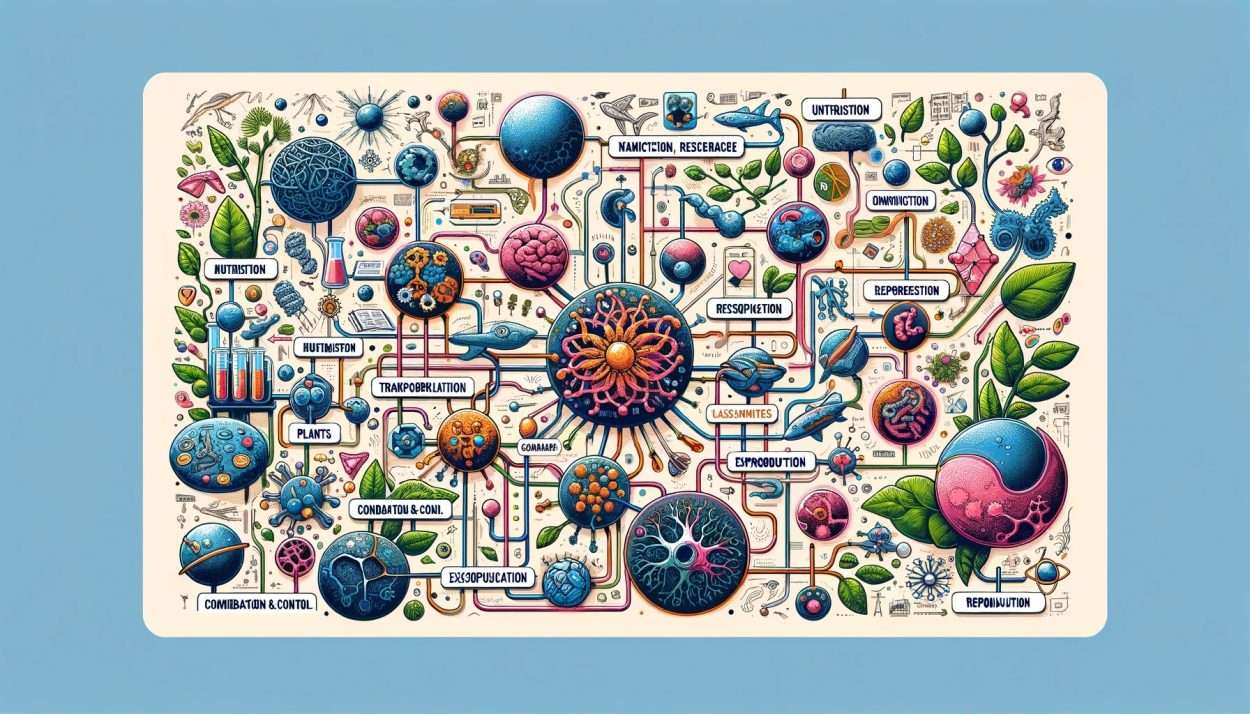
1. Introduction to Life Processes (Class 10 Science, NCERT)
Definition of Life Processes:
- What are Life Processes: Life processes are the basic functions that living organisms perform to sustain life. These include a series of activities that are essential for survival and reproduction. Life processes are what distinguish living things from non-living matter.
- Key Life Processes: The major life processes include nutrition, respiration, transportation, excretion, coordination and control, and reproduction. Each of these processes plays a critical role in keeping an organism alive and maintaining the species.
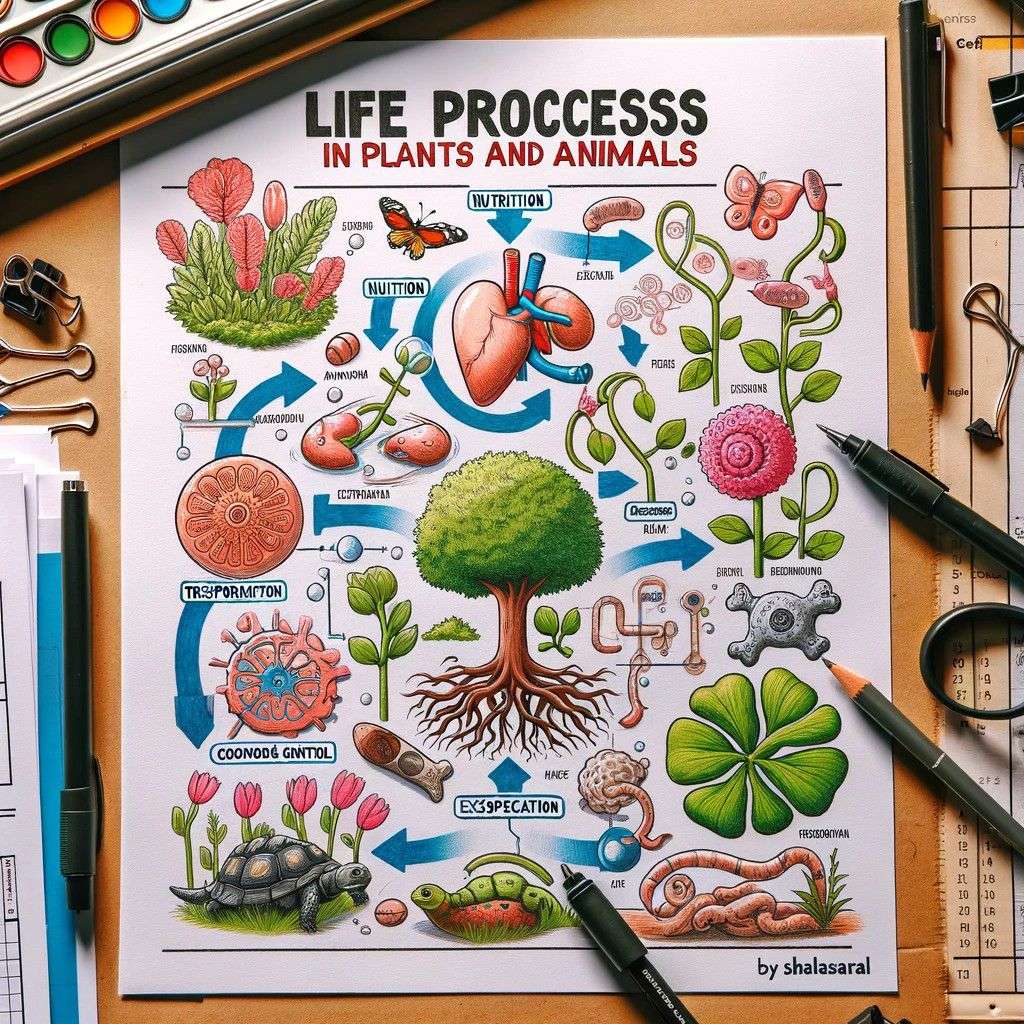
Importance in Living Organisms:
- Sustaining Life: Life processes are fundamental for an organism to maintain its vital functions. For example, nutrition provides the necessary energy and materials to grow and repair tissues, while respiration converts these nutrients into usable energy.
- Homeostasis: These processes are crucial for maintaining homeostasis – a stable internal environment in the body. For instance, excretion removes waste products to avoid toxicity, and the circulatory system helps regulate body temperature and pH balance.
- Adaptation and Evolution: Over time, life processes have evolved, allowing organisms to adapt to different environments. This adaptability is key to the survival and evolution of species.
- Interdependence: Life processes in plants and animals are interconnected. For example, plants produce oxygen and glucose through photosynthesis, which are essential for animals’ respiration. In turn, animals produce carbon dioxide, necessary for plants.
- Growth and Development: These processes are integral to the growth and development of organisms. From a single cell, organisms grow and develop into complex structures capable of various functions, all driven by life processes.
Understanding these life processes is crucial for students as it lays the foundation for more advanced studies in biology and related sciences. It offers insights into the functioning of our own bodies and the ecosystem at large, highlighting the intricate balance and interdependence in the natural world.
2. Nutrition
Types of Nutrition: Autotrophic and Heterotrophic:
- Autotrophic Nutrition:
- Autotrophs are organisms that can produce their own food. The primary method for this is photosynthesis, where light energy is used to synthesize food from carbon dioxide and water, producing oxygen as a byproduct.
- Plants, algae, and some bacteria are autotrophs. They play a crucial role in the ecosystem as primary producers, forming the base of the food chain.
- In photosynthesis, chlorophyll and other pigments absorb light energy, which is converted into chemical energy in the form of glucose. This process occurs in the chloroplasts of plant cells.
- Heterotrophic Nutrition:
- Heterotrophs cannot synthesize their own food and must rely on other organisms for their nutrition. This category includes animals, fungi, and most bacteria.
- Heterotrophic nutrition can be further classified into herbivores (plant-eaters), carnivores (meat-eaters), omnivores (both plant and meat-eaters), and decomposers (organisms that feed on decaying matter).
- The food consumed by heterotrophs is broken down into simpler substances to be absorbed and utilized by the body. This process is aided by various enzymes.
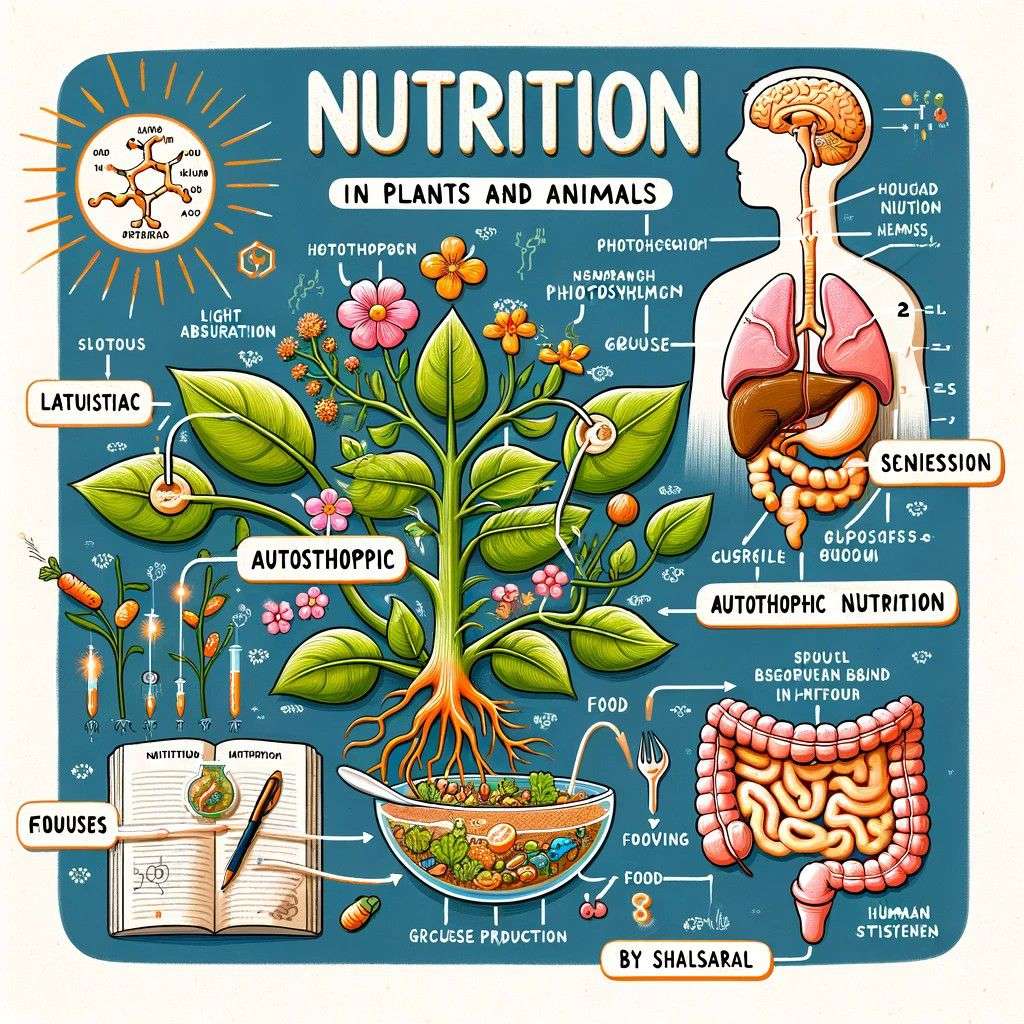
Photosynthesis in Plants:
- Photosynthesis is a complex process that occurs in two stages: the light-dependent reactions and the Calvin cycle (light-independent reactions).
- In the light-dependent reactions, which take place in the thylakoid membranes of chloroplasts, water molecules are split (photolysis) to release oxygen, and energy carriers like ATP and NADPH are generated.
- In the Calvin cycle, which occurs in the stroma of chloroplasts, the energy from ATP and NADPH is used to convert carbon dioxide into glucose.
- Photosynthesis is vital for life on Earth as it provides the oxygen we breathe and the glucose that serves as an energy source for most organisms.
Human Digestive System:
- The human digestive system is designed to break down food into nutrients that the body can use. It consists of the alimentary canal (mouth, esophagus, stomach, intestines) and associated organs (salivary glands, pancreas, liver, gallbladder).
- Digestion involves both mechanical processes (like chewing and churning in the stomach) and chemical processes (like the action of enzymes).
- Carbohydrates, proteins, and fats are broken down into simpler substances like sugars, amino acids, and fatty acids, which are then absorbed into the bloodstream and transported to cells for energy, growth, and repair.
- The process of digestion is regulated by various hormones and the nervous system, ensuring efficient nutrient absorption and waste elimination.
Understanding nutrition in both plants and animals provides insight into how energy flows through ecosystems and how living organisms sustain themselves and grow.
3. Respiration
Cellular Respiration: Aerobic and Anaerobic:
- Overview: Cellular respiration is the process by which cells convert nutrients into energy. It’s essential for maintaining the life processes of all living organisms.
- Aerobic Respiration: This type involves oxygen and occurs in the mitochondria of cells. The process breaks down glucose (or other nutrients) completely, producing carbon dioxide, water, and a significant amount of ATP (energy currency of the cell). The general equation is: C₆H₁₂O₆ (glucose) + 6O₂ (oxygen) → 6CO₂ (carbon dioxide) + 6H₂O (water) + energy (ATP).
- Anaerobic Respiration: Occurs in the absence of oxygen and is less efficient in energy production. In animals, it produces lactic acid, leading to muscle fatigue, while in plants and yeasts, it produces alcohol and carbon dioxide. The general equation in yeasts is: C₆H₁₂O₆ (glucose) → 2C₂H₅OH (ethanol) + 2CO₂ (carbon dioxide) + energy (ATP).
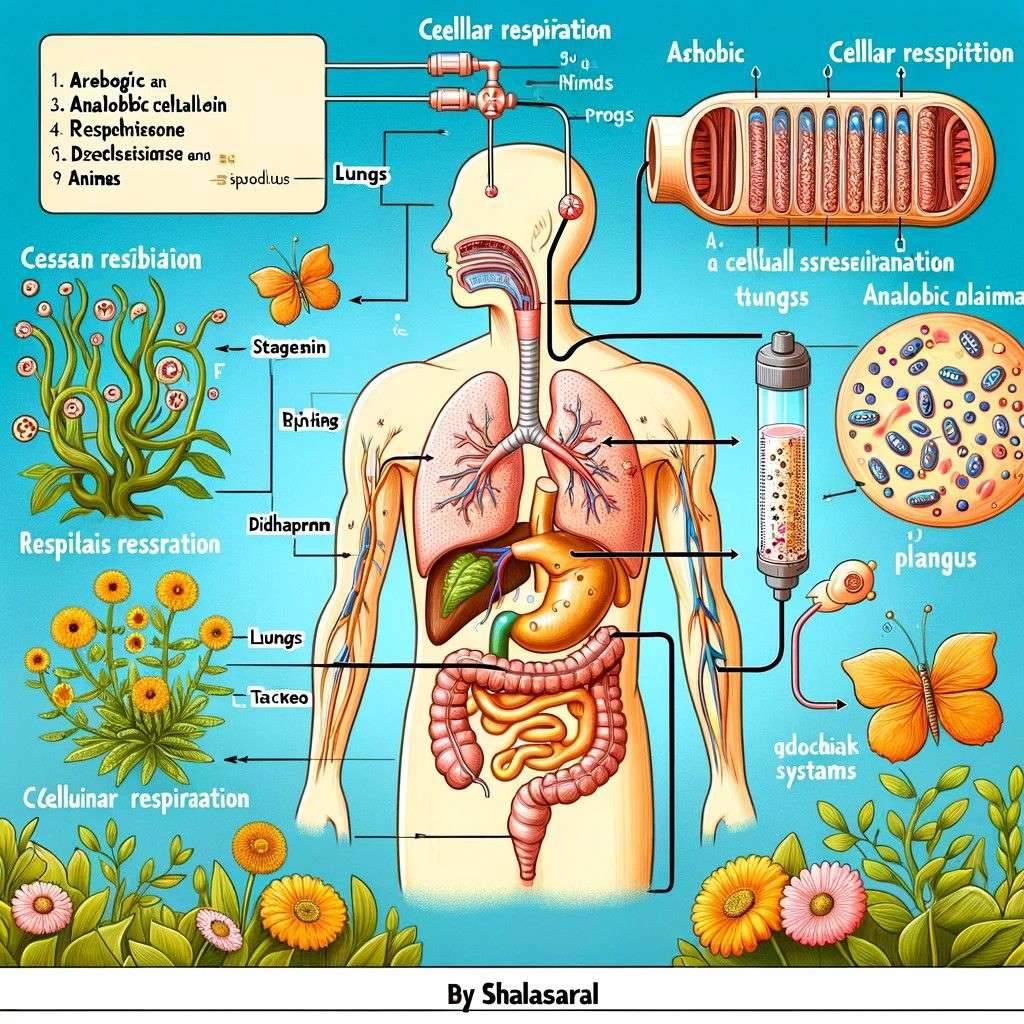
Respiration in Plants and Animals:
- In Plants: Plants respire both day and night, taking in oxygen and releasing carbon dioxide. This process is crucial for energy production, especially at night when photosynthesis does not occur.
- In Animals: Animals continuously respire to meet their energy demands. The oxygen taken in is used to break down food substances, releasing energy, carbon dioxide, and water.
Human Respiratory System:
- Structure and Function: The human respiratory system consists of the nasal passage, pharynx, larynx, trachea, bronchi, bronchioles, and lungs. Its primary function is to facilitate gas exchange – oxygen is absorbed into the bloodstream, and carbon dioxide is expelled.
- Breathing Mechanism: Breathing involves inhaling oxygen-rich air and exhaling air rich in carbon dioxide. The diaphragm and intercostal muscles play a crucial role in the process of inhalation and exhalation.
- Gas Exchange: In the lungs, oxygen from inhaled air diffuses into the blood through the alveoli, while carbon dioxide diffuses from the blood into the alveoli to be exhaled.
- Regulation: The respiratory rate is controlled by the respiratory center in the brain, which responds to the body’s oxygen and carbon dioxide levels.
Understanding respiration is vital as it’s a key
life process for energy production in all living organisms. It enables the body to utilize the energy stored in food and is essential for sustaining cellular activities. The intricacies of the respiratory system, particularly in humans, highlight the complex yet efficient mechanisms evolution has developed to sustain life.
In both plants and animals, respiration plays a complementary role to photosynthesis, balancing the oxygen and carbon dioxide levels in the atmosphere and maintaining ecological equilibrium. This process is fundamental not only in biology but also in understanding larger environmental interactions and the significance of respiratory health in humans.
Respiration at the cellular level underscores the connection between the macroscopic functions of organ systems and the microscopic activities within cells, linking organismal biology with molecular biology. This topic is essential for students to understand the interconnectedness of biological processes and the basis of metabolic activities in living organisms.
4. Transportation
Transportation in Plants: Water and Nutrients:
- Overview: Transportation in plants involves moving water, minerals, and nutrients from one part of the plant to another. This is crucial for plants as it supports various physiological processes.
- Water Transportation: Water and dissolved minerals are transported from the roots to the leaves through the xylem. This upward movement, known as the transpiration stream, is driven by transpiration from the leaves, creating a suction force.
- Nutrient Transportation: Nutrients synthesized in the leaves, like glucose, are transported to other parts of the plant through the phloem in a process called translocation. This movement is driven by a concentration gradient in a process known as phloem loading and unloading.
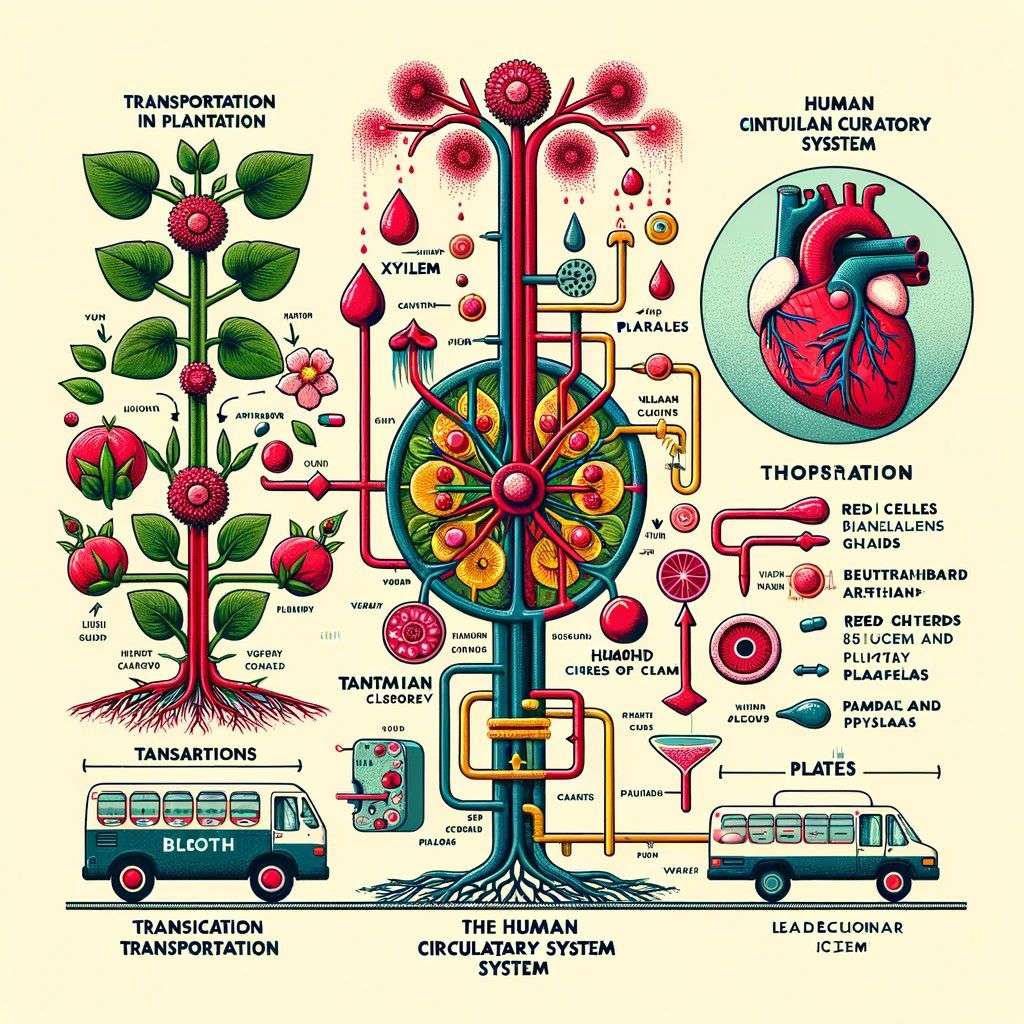
Human Circulatory System:
- Function: The human circulatory system is responsible for transporting blood, nutrients, gases, and waste products throughout the body. It comprises the heart, blood vessels (arteries, veins, and capillaries), and blood.
- The Heart: The heart is a muscular organ that pumps blood throughout the body. It has four chambers – two atria and two ventricles – that ensure a one-way flow of blood.
- Blood Circulation: There are two primary circulation pathways: pulmonary (between heart and lungs for oxygenation) and systemic (between heart and rest of the body). Oxygen-rich blood is pumped from the heart to the body, and oxygen-depleted blood is returned to the heart for reoxygenation in the lungs.
Blood and Its Components:
- Blood: Blood is a connective tissue composed of cells suspended in a liquid matrix called plasma.
- Plasma: Plasma is the liquid part of the blood and makes up about 55% of its total volume. It contains water, salts, proteins, hormones, and waste products.
- Red Blood Cells (Erythrocytes): These cells carry oxygen from the lungs to the body’s tissues and take carbon dioxide back to the lungs for exhalation. They contain hemoglobin, a protein that binds oxygen.
- White Blood Cells (Leukocytes): They are part of the immune system and help fight infections.
- Platelets (Thrombocytes): These are cell fragments that play a crucial role in blood clotting.
Transportation in both plants and humans is a vital life process. In plants, it facilitates the movement of essential nutrients and water necessary for growth and development. In humans, the circulatory system plays a crucial role in maintaining homeostasis, providing cells with nutrients and oxygen, and removing waste products. Understanding these transportation mechanisms is key in biology, offering insights into how complex organisms sustain themselves and function efficiently.
5. Excretion
Excretion in Plants:
- Overview: Plants also perform excretion, though their process is different from animals. Excretion in plants involves the removal of waste products produced during metabolism.
- Methods of Excretion: Plants excrete some waste substances into the soil through their roots. Gases like oxygen and carbon dioxide are excreted through stomata (tiny openings on leaves) and lenticels (openings on stems).
- Waste Products: Waste products in plants include oxygen (a byproduct of photosynthesis), carbon dioxide (a byproduct of respiration), and other organic compounds. Excess salts are also excreted, often stored in leaves that eventually fall off.
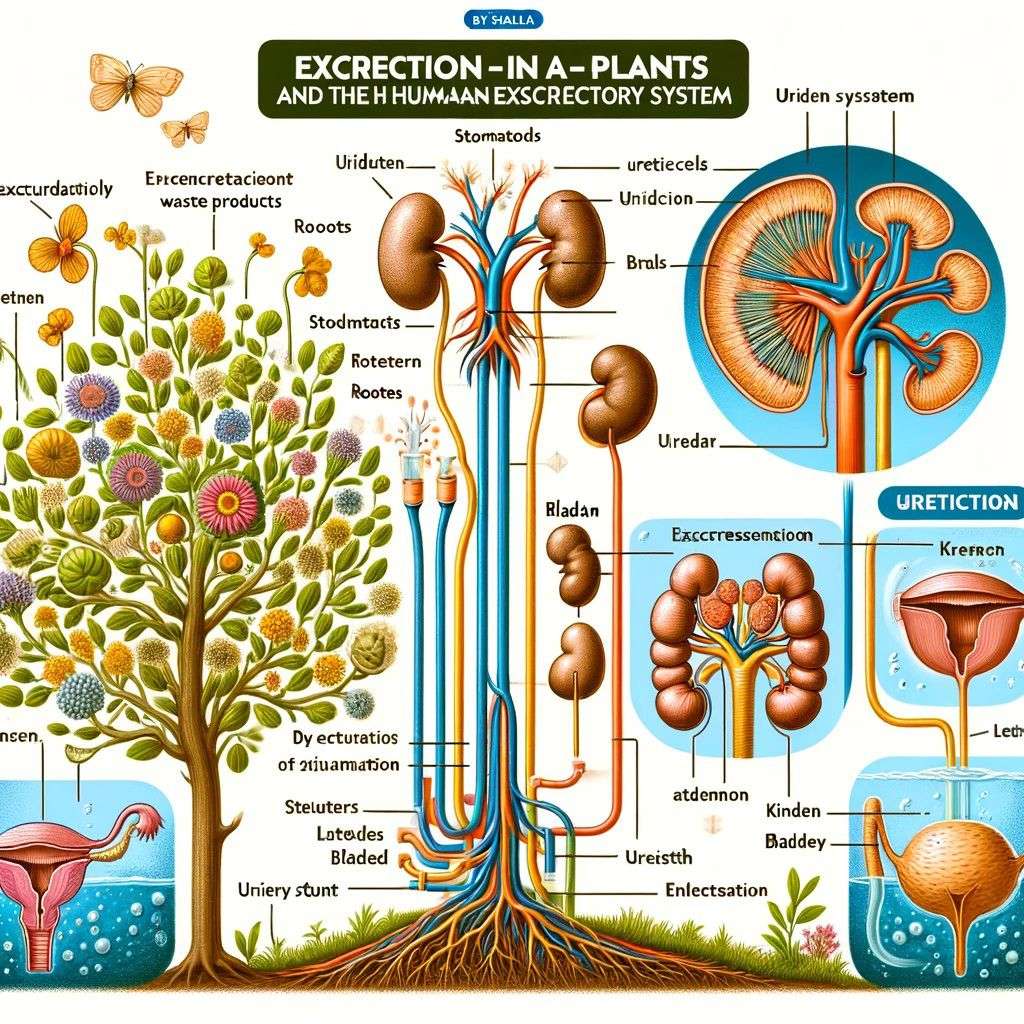
Human Excretory System:
- Function and Components: The human excretory system removes waste products from the body, primarily urea and other nitrogenous wastes produced from the metabolism of proteins. It consists of the kidneys, ureters, bladder, and urethra.
- Kidneys: The kidneys are bean-shaped organs that filter blood to remove wastes, excess substances, and toxins. They maintain a balance of salts, water, and other substances in the body.
- Formation of Urine: The kidneys produce urine by filtration of blood, reabsorption of required substances, and secretion of waste products. Urine flows from the kidneys through the ureters to the bladder, where it’s stored until excretion through the urethra.
Kidneys and Their Functioning:
- Structure: Each kidney contains about a million tiny filtering units called nephrons. A nephron consists of a glomerulus (a small blood vessel network) and a renal tubule.
- Filtration Process: Blood enters the kidneys through the renal artery and is filtered in the glomerulus. The filtrate, containing waste and other substances, then passes through the renal tubule.
- Reabsorption and Secretion: In the renal tubule, necessary substances like water, glucose, and ions are reabsorbed into the blood, while wastes are concentrated in the urine.
- Regulation of Body Fluids: The kidneys play a crucial role in regulating the volume and composition of body fluids, including electrolyte balance and pH regulation.
Excretion is a vital process for maintaining homeostasis in both plants and animals. In plants, it’s a relatively passive process involving the removal of gaseous and other waste products. In contrast, the human excretory system is a complex and active system, crucial for filtering blood, removing wastes, and regulating body fluids. Understanding the functioning of the kidneys and the entire excretory system is essential for comprehending how organisms maintain a stable internal environment.
6. Coordination and Control
Nervous System in Animals:
- Overview: The nervous system in animals is a complex, highly organized system that coordinates and controls various functions and responses. It enables animals to perceive their environment and react accordingly.
- Components:
- Central Nervous System (CNS): Comprising the brain and spinal cord, the CNS processes information and issues commands.
- Peripheral Nervous System (PNS): Consists of nerves that extend throughout the body, connecting the CNS to limbs and organs.
- Functioning: Neurons, or nerve cells, transmit electrical and chemical signals across the nervous system. Sensory neurons relay information from sense organs to the brain, while motor neurons convey instructions from the CNS to muscles and glands.
- Reflex Actions: These are immediate, involuntary responses to stimuli, such as the knee-jerk reaction, which protect the body from harm.
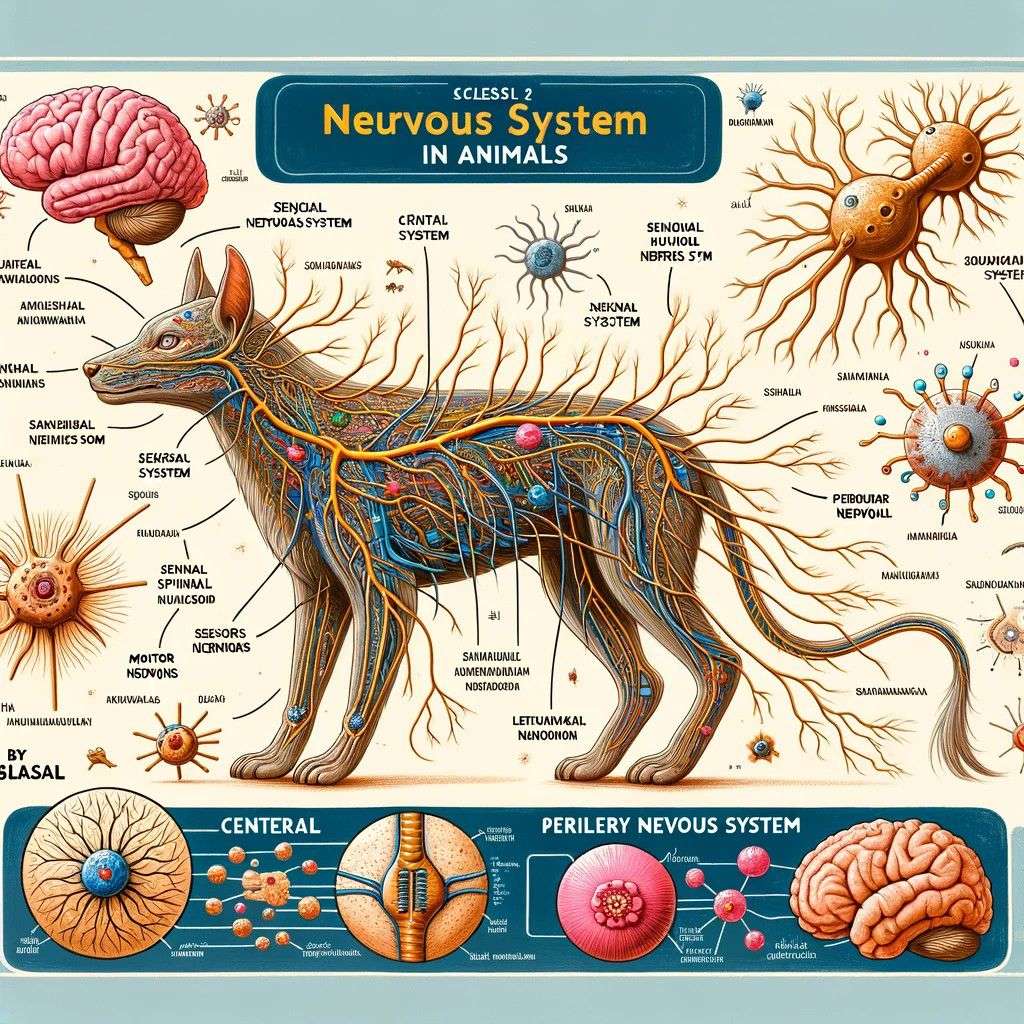
Endocrine System in Humans:
- Function: The endocrine system consists of glands that secrete hormones directly into the bloodstream. Hormones are chemical messengers that regulate various bodily functions.
- Major Glands:
- Pituitary Gland: Often called the “master gland,” it controls other endocrine glands and regulates growth, metabolism, and reproductive processes.
- Thyroid Gland: Regulates metabolism, energy generation, and calcium balance.
- Pancreas: Produces insulin and glucagon, regulating blood sugar levels.
- Adrenal Glands: Produce hormones like adrenaline and cortisol, which regulate stress responses and metabolism.
- Hormonal Regulation: Hormones act on specific target organs and have long-lasting effects. The system works in tandem with the nervous system to maintain homeostasis.
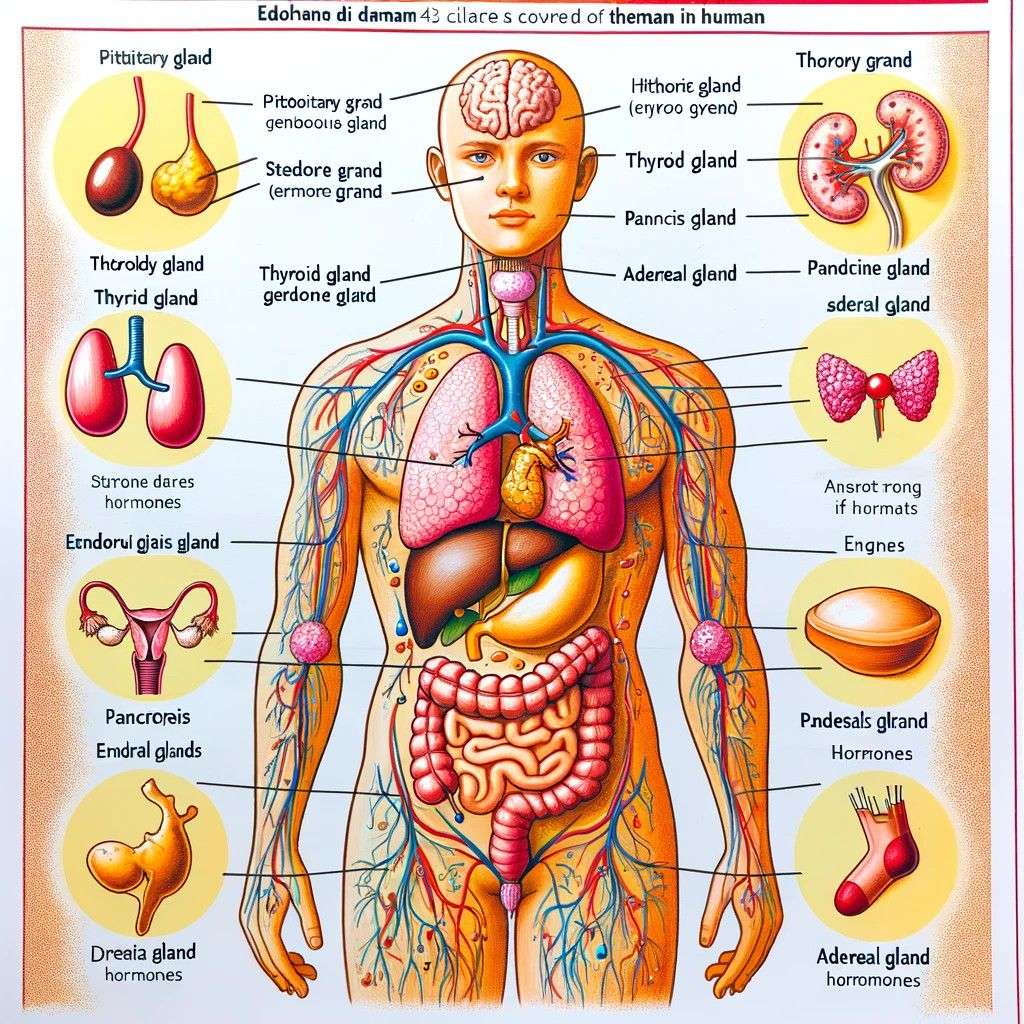
Plant Hormones and Tropisms:
- Plant Hormones: Also known as phytohormones, these are naturally occurring substances that influence growth, development, and responses to stimuli. Key hormones include auxins, gibberellins, cytokinins, abscisic acid, and ethylene.
- Tropisms: Tropisms are directional growth responses in which plants grow towards or away from environmental stimuli.
- Phototropism: Growth towards light.
- Geotropism (or Gravitropism): Growth in response to gravity; roots grow downwards (positive geotropism), while stems grow upwards (negative geotropism).
- Thigmotropism: Response to touch, as seen in climbing plants like vines.
The coordination and control systems in both animals and plants are essential for their survival, growth, and interaction with the environment. In animals, the nervous and endocrine systems work together to regulate and control bodily functions. In plants, hormones and tropisms ensure they adapt and thrive in their surroundings. These systems exemplify the complex mechanisms evolved in living organisms to maintain balance and respond to internal and external changes. Understanding these systems is crucial in the study of biology, providing insights into how life adapts and functions.
7. Reproduction
Asexual and Sexual Reproduction:
- Asexual Reproduction:
- In asexual reproduction, a single organism or cell produces offspring that are genetically identical to the parent. This process does not involve the fusion of gametes.
- Common methods include binary fission (in bacteria), budding (in yeast), and vegetative propagation (in plants like potato).
- Asexual reproduction is advantageous in stable, unchanging environments where genetic uniformity is beneficial.
- Sexual Reproduction:
- Sexual reproduction involves the fusion of male and female gametes, resulting in offspring with genetic material from both parents. This process increases genetic diversity.
- It occurs in most animals and plants and even in some microorganisms.
- The main stages include gamete formation, fertilization, and development of the embryo.
- This type of reproduction is favored in changing environments, as it allows for greater adaptability.
Reproduction in Plants:
- Sexual Reproduction in Plants:
- Involves the formation of flowers, which are the reproductive structures. Flowers contain male (stamen) and female (carpel) reproductive organs.
- Pollination, the transfer of pollen from the male stamen to the female carpel, can be facilitated by wind, water, or animals.
- After pollination, fertilization occurs, leading to the formation of seeds.
- Seeds develop into new plants, completing the cycle.
- Asexual Reproduction in Plants:
- Many plants reproduce asexually through methods like runners, tubers, rhizomes, and cuttings.
- This method ensures rapid propagation and can be used for agricultural practices.
Human Reproductive System:
- Male Reproductive System:
- Includes testes (produce sperm and male hormones), vas deferens, seminal vesicles, prostate gland, and the penis.
- Sperm production is regulated by hormones like testosterone.
- Female Reproductive System:
- Comprises ovaries (produce eggs and female hormones), fallopian tubes, uterus, and vagina.
- The menstrual cycle is a regular process that prepares the female body for pregnancy.
- Fertilization typically occurs in the fallopian tubes, and the resulting embryo implants in the uterus.
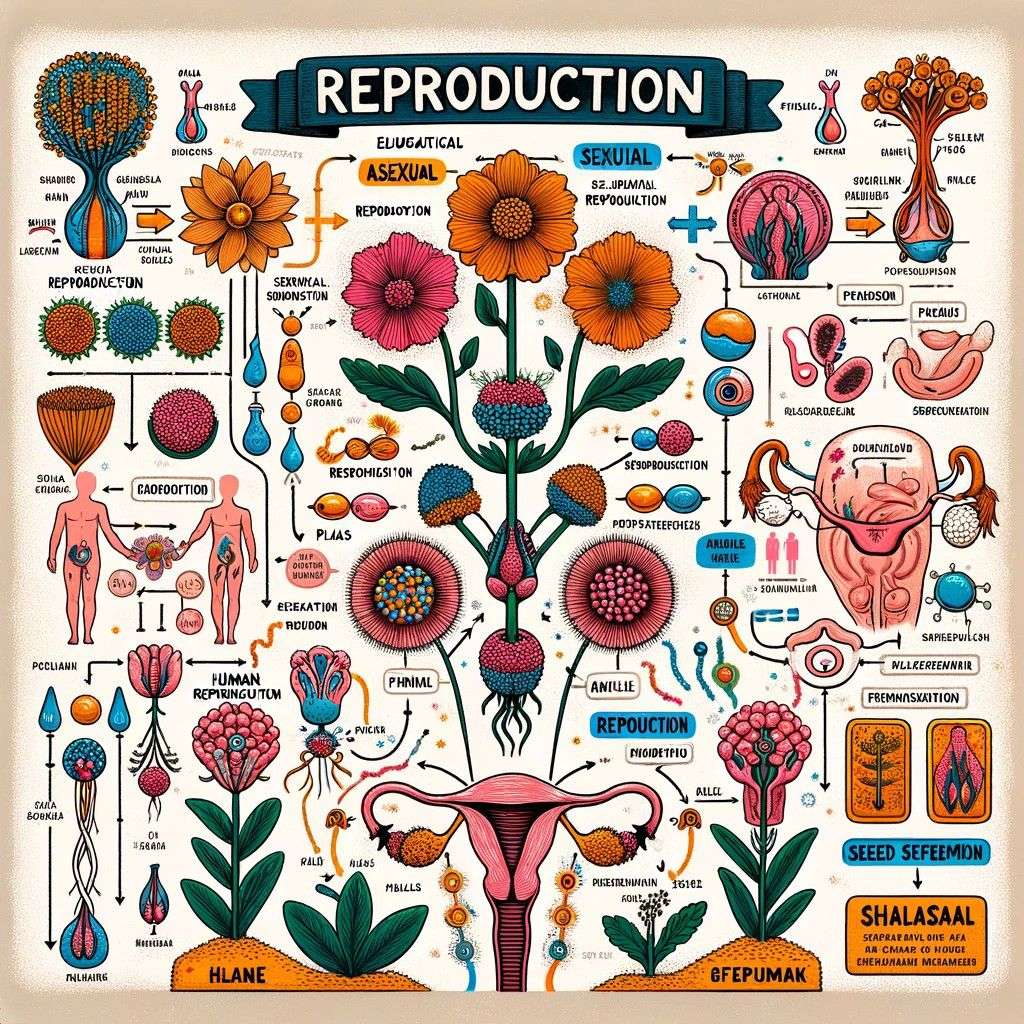
Reproduction is a fundamental biological process that ensures the continuation of species. In both plants and animals, including humans, it is a complex process that involves a variety of structures and mechanisms. Understanding reproduction is crucial for comprehending life cycles, genetics, and the continuity of life forms, as well as for applications in fields like medicine, agriculture, and conservation.
8. Conclusion
Recap of Life Processes:
- In this exploration of life processes in plants and animals, we’ve delved into the essential functions that sustain life.
- Nutrition: The process by which organisms obtain and utilize their food. In plants, it primarily involves photosynthesis, whereas in animals, it involves the ingestion and digestion of food.
- Respiration: The process of breaking down food to release energy. It occurs in every cell of both plants and animals.
- Transportation: The movement of materials within organisms. In plants, this includes the transportation of water, nutrients, and food through xylem and phloem. In animals, the circulatory system plays this role.
- Excretion: The removal of waste products. Plants do this through various means like transpiration, while animals have specialized excretory systems.
- Coordination and Control: Maintaining internal balance and responding to external stimuli. In animals, this is managed by the nervous and endocrine systems, while in plants, hormones and tropisms play a significant role.
- Reproduction: The process of producing new individuals. In plants, this can be sexual or asexual, and in animals, it primarily occurs through sexual means.
The Interconnectedness of Life Processes in Organisms:
- These life processes are not isolated events but are intricately interconnected and interdependent.
- For example, nutrition provides the energy necessary for other life processes, including respiration, movement, growth, and reproduction.
- The waste products from respiration are used in plants for photosynthesis, demonstrating a symbiotic relationship between plants and animals.
- The coordination and control systems regulate and integrate all these processes, ensuring that organisms respond appropriately to their environment and maintain homeostasis.
- This interconnectedness highlights the complexity and efficiency of living organisms, and how each process, while distinct, is part of a larger, unified system of life.
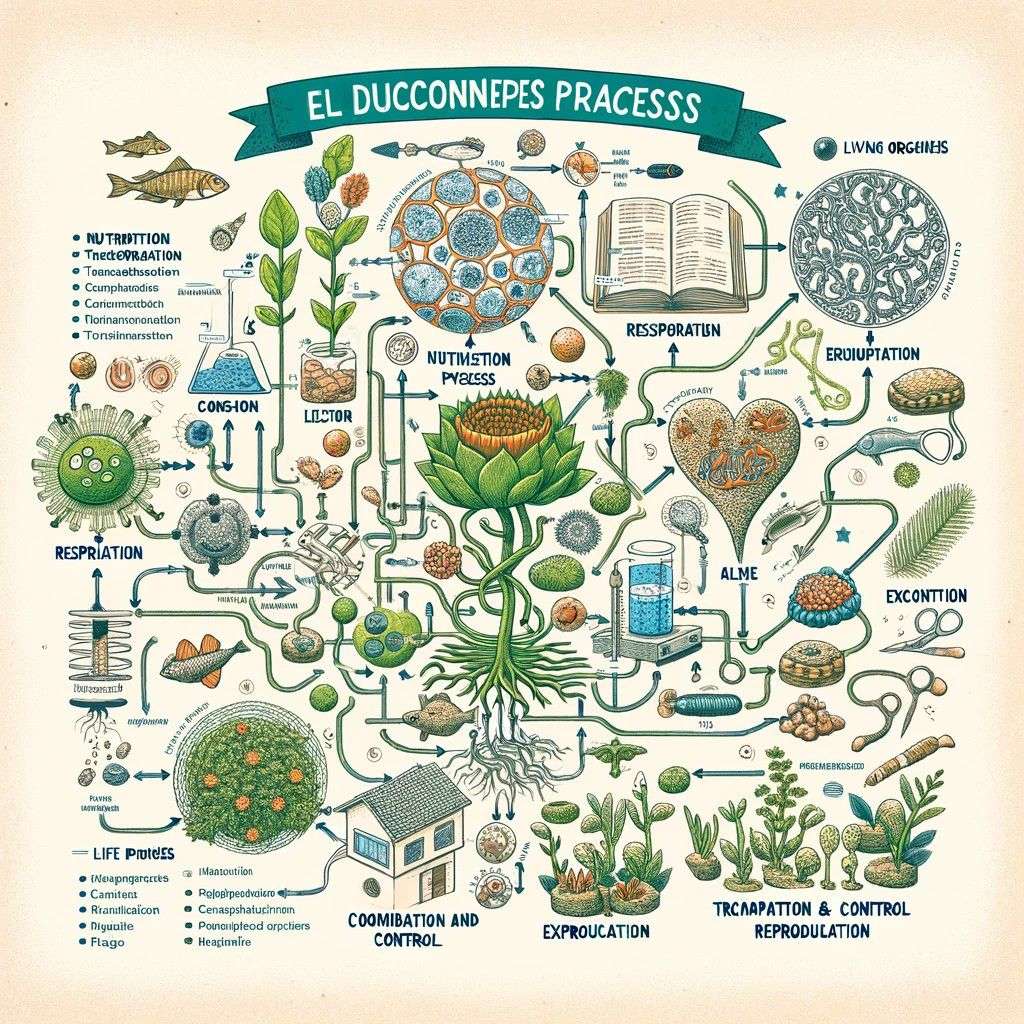
In conclusion, understanding these life processes is crucial for appreciating the complexity of life and the incredible ways in which different organisms have adapted to survive and thrive. This knowledge forms a foundational aspect of biology and helps us understand our own bodies, the environment, and the diverse forms of life that share our planet.